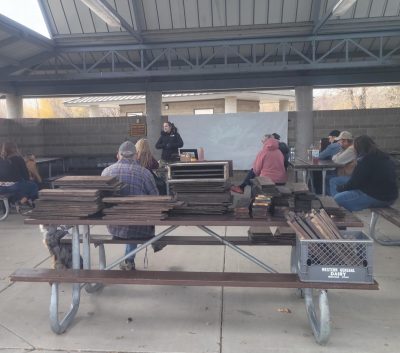For the fourth consecutive summer, some Wyoming cities and towns will be going a bit batty.
The University of Wyoming Biodiversity Institute will host three free Summer Bat Walks, with walks currently scheduled in Cheyenne, Evanston, and Sheridan—and the possibility of more to come.

“My hope for people who attend a bat walk is that they get excited about seeing and learning more about our native nocturnal wildlife and, hopefully, they will share some of that enthusiasm and learning with others in their community,” says Mason Lee, senior project coordinator of the Biodiversity Institute, who leads the walks. “Bats are a really fascinating wildlife group in Wyoming but, because they fly at night and we generally can’t hear them, I think they’re also an overlooked group. Eighty percent of bat species worldwide need conservation action, and spreading the word about how amazing bats are is something that anybody can do to contribute toward their conservation.”
Bats are invaluable to Wyoming and to ecosystems around the world. All bats in Wyoming—of which there are 18 species—are insectivores, and they eat a lot of crop pests. It is estimated that, in the U.S., bats save farmers $3 billion each year in pest control, Lee says. Insectivorous bats help protect crops, including corn, cotton, potatoes, and wheat.
“Despite their small size, bats are incredibly valuable wildlife to their ecosystems. In Wyoming, our bats are all insectivorous, and they can eat a lot of bugs. Just one individual little brown myotis can eat 500 mosquito-sized insects an hour,” Lee says. “A lot of the insects that bats forage on are agricultural pests. Across the world, many farmers install bat boxes near their fields to encourage bats to forage and protect their crops. Bat species that are frugivores are vital for seed dispersal. Over 500 plant species are exclusively pollinated by bats.”
During previous bat walks, big brown bats, hoary bats, and little brown myotis were those most often seen, but other species have often been spotted as well, Lee says.
“These three species are common and widespread, whereas a number of our bat species are uncommon, have much smaller ranges, or are more restricted in the habitat types that they occupy and forage in,” says Lee, who is a certified Bat Walk Ambassador through Bat Conservation International (BCI). “But we certainly do pick up different species at each of our bat walk locations, so it’s not that we only see and hear big browns, hoary, and little browns.”
BCI is an international, nongovernmental organization working to conserve the world’s bats and their habitats through conservation, research and education efforts. The Biodiversity Institute is the only certified Bat Walk Ambassador to offer this program in Wyoming. Bat walks are designed to introduce communities to the amazing and beneficial flying mammals that live in their areas.
Most bats echolocate at a frequency that is too high for human ears. But a device, known as an Echo Meter Touch, that Lee takes on the walks “translates” their calls to a lower frequency that can be heard by people. For a recording of bats during a previous bat walk, go to https://vimeo.com/717518476.
“Our Echo Meter Touch picks up bat calls in the area, and the app translates those calls to a frequency that humans can hear,” Lee says.
Bats also have chatter or social calls, which they emit when they’re in bat boxes, which are artificial roosts. These chatter or social calls are at lower frequencies, which humans can sometimes hear, Lee says.
The bat walks are capped at 20 participants each.
“It’s easier to see and hear all of the bats when we have these smaller groups,” Lee says.
Locations, dates and times of bat walks are as follows:
- Evanston — Bear River State Park, Tuesday, June 25, 8:30-10 p.m.
- Sheridan — South Park open space, Tuesday, July 16, 8:30-10 p.m.
- Cheyenne — Curt Gowdy State Park, Wednesday, Aug. 7, 8-9:30 p.m.
To register for a Summer Bat Walk, go to http://wyobiodiversity.org/index.php/outreach/bat-walks.
Local organizations that would like to host a bat walk in their community this summer can email biodiversity@uwyo.edu.
About the University of Wyoming Biodiversity Institute
The UW Biodiversity Institute fosters conservation of biodiversity through scientific discovery, creative dissemination, education and public engagement. In this setting, scientists, citizens, students and educators come together to share a wealth of perspectives on the study and appreciation of biodiversity — from microbes to poetry and ecosystems to economics. Learn more at www.wyomingbiodiversity.org.
This story was originally published on UW News.




